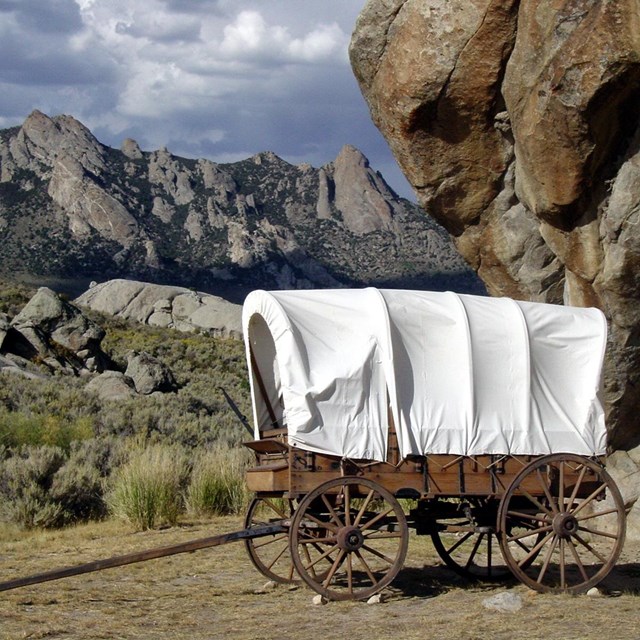Last updated: March 28, 2022
Article
Chapter 1: Race, Slavery, and Freedom - The Question of Race
Sweet Freedom's Plains
African Americans on the Overland Trails 1841-1869
By Shirley Ann Wilson Moore, PhD.
For the National Park Service
National Trails Regions 6, 7, & 8
Introduction/Table of Contents
Chapter 1 Sections
- The Early Black Presence
- The Question of Race
- The Evolution of Their Status
- The Contagion of Liberty
- Permanent, Hereditary Chattel: A Snapshot of Antebellum Slavery in the South, Indian Territory, and Border States
- Northern “Unfreedom”
- The Nature of Freedom in the West
- Utah: Slaves and Saints
- No Rights to be Respected
Early explorers like Esteban, de Padilla’s interpreter, York, and Beckwourth undoubtedly were of African ancestry. But the issue of race—who was “white” and who was not—became a pressing one for the Europeans who colonized the “New World.” From the beginning, race has been a complex and contentious subject in America. By the sixteenth century, it was becoming a social rather than a national or biological identity. By the time of the great overland emigrations, it was being used (though not always successfully) to thwart attempts by African Americans (and others) to contest their status and define themselves.
Beginning in Hispaniola in the late fifteenth and early sixteenth centuries, Spanish explorers slaughtered and attempted to enslave the Indian peoples they encountered, believing them to be culturally and racially inferior. Historian Winthrop Jordan has written that among seventeenth- and eighteenth-century Europeans, “the most common assumption was that the original color of man was white.” Deviation from the original was evidence of degeneration and inferiority. Variations from the original needed to be eliminated or, at very least, controlled for the sake of a well-ordered and moral society. Therefore, the need to differentiate between “white” and “other” gave rise to a system of racial categories based on an “imagined quantum of blood” and certain physical characteristics.13
In the territories held by Spain and Mexico, an elaborate system of racial classification was put in place. The Spanish “Sistema de Castas” (System of Castes) was a hierarchy of more than 40 racial classifications (castizo, morisco, mestizo, mulatto, indio, negro, etc.) designed to delineate degrees of whiteness. For social and political purposes negro (black) was the least desirable, while español (Spanish) was the most desirable. Under this system, people of African ancestry were also vulnerable to enslavement, exploitation, and marginalization, but still might achieve a measure of social and economic mobility. This was particularly true on the frontier of New Spain (what is now northern Mexico and the southwestern United States) where people were needed to establish settlements. African American history curator Rick Moss has observed that the type of rigid social discrimination based on race that had emerged in the United States “failed to take root in the complex multiracial society” of the Spanish and Mexican territories of the West. With the American takeover of the Mexican holdings in the mid-nineteenth century, however, the relative social fluidity enjoyed by people of color ended.14
White Americans began to set aside the long-held definition of race as nationality and adopted a new one that emphasized ethnicity and color. As early as the first decades of the seventeenth century, European colonizers on the eastern seaboard were enacting laws designed to define “white” and “other.” For blacks and Indians, consignment to the category of “other” often meant enslavement. Permanent, hereditary servitude (chattel slavery) became the primary indicator of race, and color became “the sign of slavery.”15 African Americans and other people of color, including Indians, Asians, and Hawaiians (Kanakas) were classified as “others,” and were given the same racial identity and social status. By the nineteenth century, the “one drop rule” was the standard for determining race in the United States. It dictated that an individual with any degree of “African blood” was black and therefore presumed to be a slave or subject to enslavement. The one-drop rule took precedence over parentage and birthplace. It was invoked irrespective of skin color or degree of “whiteness,” and it blocked social and economic mobility. Race became an expedient means by which to confer or deny inclusion in society.16
Next Section - Chapter 1, Race Slavery Freedom: The Evolution of Their Status
13 Winthrop D. Jordan, White Over Black: American Attitudes Toward the Negro, 1550-1812 (Chapel Hill: The University of North Carolina Press, 1968), 248-259; Nicholas Hudson, “Nation to ‘Race’: The Origin of Racial Classification in Eighteenth-Century Thought,” American Society for Eighteenth Century Studies 29, no. 3 (Spring 1996): 247-264, especially 252-258; Walter Johnson, “The Slave Trader, the White Slave, and the Politics of Racial Determination in the 1850s,” The Journal of American History 87, no. 1 (June 2000): 13-38, especially 16-17.
14 Herbert G. Ruffin II, “Sistema de Castas (1500s-ca.-1829),” The Black Past: An Online Reference Guide to African American History, BlackPast.org, http://www.blackpast.org/?q=aaw/sistema-de-castas-1500s-ca-1829 [accessed July 4, 2011]; Taylor, In Search of the Racial Frontier, 37-48; McDonald, “To Be Black and Female in the Spanish Southwest,” 35-49; Moss, “Not Quite Paradise,” 225.
15 Theresa Zackodnik, “Fixing the Color Line: The Mulatto, Southern Courts, and Racial Identity,” American Quarterly 53, no. 3 (September 2001): 420-451, especially 420-430, 432, 433 for quote, and 448 n26.
16 Jordan, White Over Black, 44-98; Hudson, “Nation to Race,” 248-253; and Zackodnik, “Fixing the Color Line, 420-430, 432-433, 448 n26, 451 n90. A Negro was defined as having as little as one-fourth, one-eighth, one-sixteenth, one-thirty-second, or one drop of “black blood.” In addition, inspections of skin, hair, nose, teeth, fingernails, and even feet were used to determine race. See also Victoria E. Bynum, “‘White Negroes’ in Segregated Mississippi: Miscegenation, Racial Identity, and the Law,” Journal of Southern History 64, no. 2 (May 1998): 247- 276, especially 266; and Johnson, “The Slave Trader, the White Slave,” 21-25.




